

Lotus Esprit GT3
The 1997 GT3 is the same as the Esprit S4 except for the following changes.
• 2 litre (type 920) 240 bhp engine • No back pressure valve or throttle jack • No tailgate mounted aerofoil • Swiss type rear transom spoiler lip • single fuel filler on LH side • GT3 decals along door bottoms • Sport 300 type seats with backs painted body colour • Cloth/vinyl interior trim • Senotex instrument masks • Body colour composite gear lever shroud • Aluminium gear lever knob • Optional panel lamps rheostat • alarm • door edge, bonnet and footwell lamps • lights on buzzer • one touch windows.
1998 onwards
The 1998 model year retains the classic characteristics and pure driver appeal of the GT3 while incorporating a number of the refinements developed for the Esprit V8 and V8 GT.
These all increase the user friendliness of the car, complying with the successful GT3 concept of ensuring that the appeal of the Esprit is within the reach of newcomers to the supercar market.
The Esprit GT3 possesses the legendary Lotus ride, handling, and styling, powered by a special 2.0 litre variant of the 4-cylinder Lotus turbocharged engine.
This highly developed engine produces 179 kW (240bhp) at 6250 rpm and 294 Nm (216lb.ft) at 3750 rpm and enables the car to produce performance figures to shame more expensive supercars – 0-60 mph in 5.1seconds (0-100 km/h in 5.2 seconds), 0-100 mph 12.9 seconds (0-160 km/h in 12.5 seconds) before reaching a top speed of 163.5mph (263 km/h).
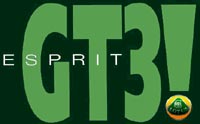
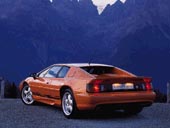
A new light weight Kelsey Hayes ABS braking system developed for the Esprit enhances stopping performance and increases vehicle stability in extreme conditions while maintaining a progressive feel.
The centre console has been dramatically improved with all the primary and secondary controls, including new electric window switches, within easy reach of the driver and passenger.
The fascia has been designed to maximise interior space, ergonomically improve the layout of the instrumentation and controls. The new, smaller binnacle, centre console and lowered transmission tunnel top, all combine to make the cabin much more spacious while graphically wrapping around the driver. The instrument layout has been honed down to the absolute minimum. The four highly legible VDO instruments: speedometer incorporating a LCD odometer and trip, electronic rev-counter, fuel and temperature gauges, together with the warning and indicator lamps, are all laid out for maximum clarity.
Fuel tank release, dashboard rheostat, window override and alarm immobiliser are now discretely housed within the tunnel behind the gear lever. The result is a more spacious, ergonomic cabin complemented by the specification and equipment selection, such as the racing style fixed back composite bucket seats, and reflect the motorsport pedigree of Lotus. On-board comfort is further improved by new heating and ventilation controls and graphics with repositioned air vents, allowing more precise cabin temperature and air distribution control.
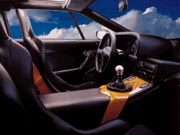

The exterior appearance brings back memories of the classic line of the early Lotus Esprit, which did not use added wings the aerodynamic downforce at the rear of the Lotus Esprit GT3 has been achieved with just an extended lip on the rear bodywork.
A new wiper has been designed comprising a new wiper arm and blade. This new pantograph wiper system improves screen clearing with an increased sweep area and quieter operation. The windscreen wash system also adopts of a more powerful pump and a larger capacity reservoir.
The 1998 Esprit configuration is completed by the introduction of a new Cobra alarm system. This EC approved Thatcham Category 1 system incorporates remote arming and disarming, central locking and key operated dead locking on both driver and passenger doors.
The Lotus Esprit GT3 is available in European specification markets, in both left-hand and right-hand drive and can be personalised with a full range of options.
GT3 Braking Systems
The early GT3 cars had the Delco ABS Braking system (as used on S4 & S4s) There was limited stock of this component (originally only enough to build the originally planned build quantity of GT3s)
The GT3 proved to be more successful than thought and more were planned for build. This meant they had to take the new Kelsey Hayes ABS Braking system developed for the V8. This system relies on using a conventional vacuum brake servo which was developed for the V8 vacuum levels.
As the 4 cylinder engine does not have the same vacuum characteristic it was easier to keep the same braking components and generate the vacuum in another way - with an existing electric pump. The remaining GT3s were built to this condition (the change happened during 1997)
Esprit Production Figures
1976-2004
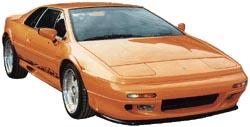
 LOTUS
ESPRIT GT3 SPECIFICATIONS
LOTUS
ESPRIT GT3 SPECIFICATIONS
Engine:
Type 920
Mid-mounted Lotus 1973cc aluminium alloy 16-valve chargecooled engine.
Water-cooled TB03 turbocharger with integral wastegate.
Multi-point fuel injection system and distributorless ignition.
Maximum power: 179 kW (240 bhp) at 6250 RPM (DIN).
Maximum torque: 294 Nm (216 lb ft) at 3750 RPM (DIN).
Compression Ratio: 8.0:1 Bore: 95.27 mm
Stroke: 69.20 mmTransmission:
High torque 5-speed manual transaxle with hydraulically operated clutch driving rear wheels.Chassis:
Rigid steel zinc-coated backbone chassis, composite bodywork with seating for two.
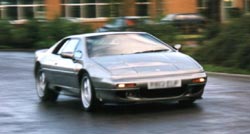
Fuel System:
Fuel tank capacity: 73 litres (16 gallons).
Fuel requirement: 95 RON minimum octane UNLEADED.Front Suspension:
Independent by upper and lower wishbones, with revised anti-roll bar, coil springs and telescopic dampers. Power steering (PAS) fitted as standard.Rear Suspension:
Independent by upper and lower transverse links, with radius arms, coil springs and telescopic dampers. Aluminium hub carriers.Brakes:
New Kelsey Hayes "430" three-channel ABS controller with tandem master cylinder and vacuum servo assistance.Wheels:
5-spoke alloy, 17" diameter. 7J front and 8.5J rear rim sizes by Route OZ to Lotus design.Tyres:
Unique Goodyear Eagle GS-A asymmetric.
Front: 215/40ZR 17 Rear: 245/45ZR 17Performance:
Maximum speed: 163.5 mph (263 km/h)
0-60 mph 5.1s 0-100 km/h: 5.2s
0-100 mph 12.9s 0-160 km/h: 12.5sFuel Consumption:
(mpg (l/100 km))
Urban 14.9 19
Extra Urban 32.8 8,6
Combined 22.6 12,5Kerb weight: 1229kg
Unladen weight: 1230kgStandard Equipment:
Lotus sport seats, vinyl interior trim, power steering, ABS brakes, catalytic convertor, single key central locking, tilt/removable roof panel, front fog lights, electrically adjustable heated door mirrors.Options:
Airbags, leather trimmed sport seats, leather trimmed seats, Lotus alarm system, air conditioning, Alpine radio cassette, Alpine radio/CD, Alpine radio with CD multichanger.
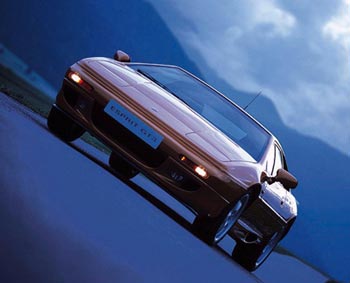
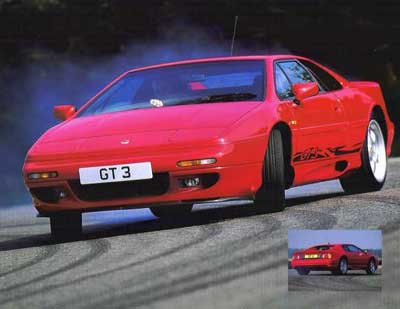
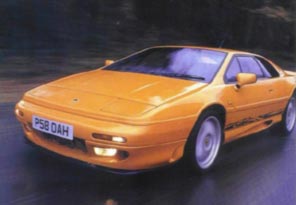
|
|